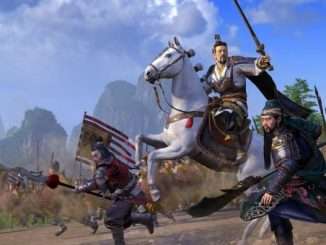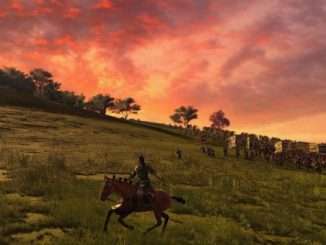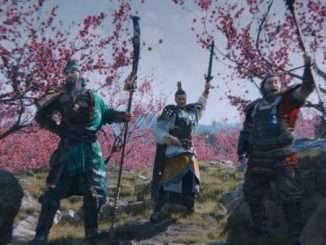
Other Total War: Three Kingdoms Guides:
- Getting Started.
- Beginner’s Guide (Tips and Tricks).
- Advanced Tips and Tricks.
- Resources and Campaign Maps.
- Damage Types and Effects.
- Spies & Espionage Guide.
- Zone of Control Guide.
- Administrators Guide.
- Fortifications Guide.
- Formations Guide.
- Diplomacy Guide.
- Factions Guide.
- Terrain Guide.
- Fatigue Guide.
- Morale Guide.
- Armies Guide.
- Unit Abilities.
- Battle Types.
- Siege Guide.
- Court Guide.
- Duels Guide.
- Unit Types.
Commandery
Commanderies are the many territories of ancient China, connected in a vast patchwork that make up the THREE KINGDOMS campaign map. They are delineated by boundary lines which are colour coded according to your diplomatic relationship with the owning faction. White lines indicate the boundaries of neutral territory; blue lines indicate the boundaries of friendly or allied territory; red lines indicate the boundaries of a faction you are at war with.
Commanderies contain settlements which generate tax income, resources, and many other benefits for the owner, based on which buildings have been constructed there. Each commandery consists of a commandery capital and one or more attached counties. Ownership of the capital defines ownership of the commandery, though attached counties may be captured and occupied by other factions.
At higher faction ranks, you can raise or lower your faction’s tax level using the tax slider in the treasury panel.
Commandery capital
Capitals are the heart of your faction’s infrastructure, the place where you’ll construct the many buildings that improve your economy, generate income, and bring benefits to your populace and armed forces.
County
A commandery is divided into multiple counties. The commandery capital constitutes a county in its own right, alongside any other counties within the commandery. Such counties house smaller resource-generating settlements, such as a farms, mines and temples. Selecting any settlement opens the commandery panel, which displays all the commandery’s various counties, and who owns them.
Corruption
As commaderies grow and develop, corruption rises, effectively reducing the tax income from your commanderies. Other income sources, such as trade or diplomacy, are not affected by corruption.
You can combat corruption by employing administrators, assigments, constructing certain buildings and researching certain reforms.
Buildings
You can construct buildings in your commanderies and counties in order to expand and improve your infrastructure. By doing this you can generate greater income, increase food production and storage, grow your population, enhance your prestige, and much more besides.
Buildings are built in the commandery panel, which is displayed when you select one of your commanderies or counties. Each commandery capital has a town centre, which generates prestige each turn, boosts the commandery’s population capacity and food reserves, and performs more diverse functions as it is upgraded.
Buildings cost money to build, and some buildings require a further upkeep cost each turn to maintain. You can only build one building at a time in each commandery, and more advanced buildings take longer to build, though if you have the funds, you can throw money at the problem and use the Rush Construction button located on the building slot to instantly complete it.
To the right of the town slot are further slots within which you can build new buildings or upgrade existing ones. Upgrading the town centre expands the settlement to unlock further building slots.
Mousing over an empty building slot will display which buildings may be constructed there. Mousing over an existing building will display information on that building’s function and bonuses, and right-clicking it will show you the entire building chain, so you can scrutinise the future bonuses it will grant when upgraded.
Some buildings will not become available until they are unlocked through new reforms. If this requirement is shown on the building, clicking the reform symbol will open the reforms panel and highlight the required reform.
There is a wide variety of buildings available, across five colour-coded categories.
Agricultural buildings (green):
These include buildings such as livestock and grain farms, food storage, and land development centres. Development and storage buildings are generally constructed in the Commandery capital, while farms are situated in counties away from the commandery capital. Broadly speaking, green buildings enhance food, peasantry income and reserves. As the people support the military, green buildings reduce the construction costs of red buildings.
Military buildings (red):
These buildings, such as military forges, conscription centres and military infrastructure buildings, bring benefits to your armed forces through improved military supplies, reduced recruitment and upkeep costs, increased food reserves and more besides. It is important to note that higher-tier unit types are not unlocked by military buildings, but through reforms, character levels and becoming emperor. As the military supports the government, red buildings reduce the construction cost of yellow buildings.
Government buildings (yellow):
Government buildings encompass tax collection, temples and administrative functions. They boost income, improve public order, combat corruption, and much more. They are also an important source of prestige. As the government encourages and stimulates industry, yellow buildings reduce the construction cost of grey buildings.
Economic buildings (grey):
These include buildings such as state-held or privately-owned workshops, and labour housing. These buildings increase your income from industry and commerce, boost population growth, and reduce corruption through the standardisation of coinage. As the output of the craftsmen flows into the marketplace, grey buildings reduce the construction costs of blue buildings.
Learning and market buildings (blue):
These buildings include schools, trade and mercantile offices, and hostelries. They improve income from a number of sources, improve your trade influence, and enhance character satisfaction. Certain high-tier market buildings can also increase the undercover network cost of enemy spy actions. As schools and markets bring education and profit to the people, blue buildings reduce the construction costs of green buildings.
Garrison
Each settlement maintains a garrison force in the event that an enemy army attacks. The composition of a garrison – which units it contains and how many – is defined by the buildings in the settlement and the presence of an administrator. You can view a garrison by selecting a commandery or county and clicking the green garrison symbol to the left of the relevant building slot.
The commandery town-centre building provides a single retinue (six units) to the garrison force. Another retinue may be added by building a garrison military (red) building. A third retinue will be added if an administrator is assigned to the commandery, though his retinue will not contribute to the garrison if the administrator has been recruited to an army (his retinue will appear in the army instead).
If a settlement is attacked by an enemy army, the garrison will appear in the ensuing battle (or counted towards the settlement’s defence if the battle is delegated) as an army under the defender’s control. If an army is also stationed in the settlement, the army and the garrison will fight together.
A garrison is bound to its settlement and cannot be ordered to leave. However, if a battle occurs involving a friendly army within the settlement’s zone of control, the garrison will sally out and join the friendly army for the duration of that battle.
Garrison forces which become damaged in battle and replenish just like any other army. Individual garrison units which are destroyed in battle will be re-recruited automatically over time.
Tax
Tax is the chief source of income for your faction. It is generated in your commanderies, and is derived from three main sources, as follows.
Peasantry income is a tax on the people, and scales with the commandery’s population. The higher the population, the more tax the commandery generates.
Commerce income is derived from certain market (blue) buildings that are constructed in the commandery. Buildings which generate commerce income (such as the harbour building chain for example) do not generate large amounts of income by themselves, but synergise extremely well with other blue building types to create large multipliers for commerce income. The market wharf building chain, for example, generates no commerce income of its own, but greatly enhances the commandery’s commerce income from other sources (such as the harbour building chain).
Industry income is derived from any industrial sources in the commandery, such as mine and toolmaker counties for example. Industry sources tend to provide a higher base level of tax income than commerce sources, but offer fewer inter-building synergies for enhancement of that income.
You can view a commandery’s combined income from taxes and other sources in the commandery panel. You can view your faction-wide tax income in the Treasury panel.
You can exempt a commandery from taxation by toggling the tax exemption box in the Commandery panel. This can improve matters in a commandery that is suffering from low public order.
As you advance your faction rank, you’ll gain the ability to modify the tax rate in a more granular fashion, increasing or decreasing them to balance income requirements with public order across you commanderies using the tax slider in the treasury panel.
Any bonuses from characters, buildings, administrators etc which are marked as improving ‘income from peasantry/commerce/industry’ will enhance the taxes you collect in a commandery without raising the tax rate. The Tax Collection building chain is one such source.





Be the first to comment